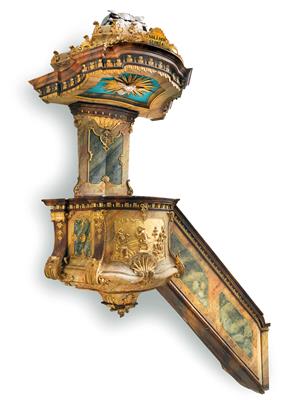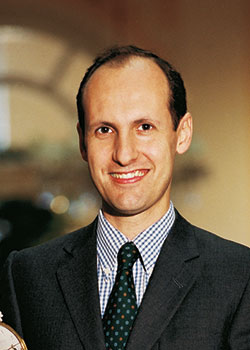Rare baroque pulpit,

Austria-South Germany 18th century, 5-part construction from softwood, swelling and curved carcase with relief and polychrome painted appliqués (parable of the sower), rich gold painting, ornamental carved volute decoration, Middle piece in same decoration, above it a cupola with so-called sound cover and aureole, also with dove of peace, above which clouds in silver paint, side staircase in marble-effect finish, mounted height ca. 475 cm, overall height (without side staircase): 330 cm, the pulpit alone ca. 150 x 160 x 90 cm, middle piece ca. 150 x 90 x 14 cm, cupola ca. 95 x 190 x 110 cm, Length of staircase handrail ca. 260 cm, some cracks, small pieces of wood and paint missing, signs of age. (DOC)
The pulpit is a raised place in churches, synagogues and mosques from which the priest pronounces the word of God and gives the homily.
The word comes from the Latin cancelli “grille, gates”. In the early Christian period preaching took place from the ambo near the gates between the choir and the nave. The pulpit as a gallery for the homily was an invention of the preaching (mendicant) order of the 13th century. The larger the church and the greater the significance attached to preaching, the higher and more artistically decorated the pulpit. The basic elements are the decorated pulpit carcase, equipped with a reading stand, of polygonal, mainly octagonal ground plan which rests on a foot or support and to which a staircase leads, either from within the church or through the outside wall, and the equally often decorated sound cover, which can by means of a rear wall be visually linked to the body of the pulpit. The staircase and the pulpit are usually separated by a door.<brThe spatial positioning of the pulpit was handled in different ways; the dominant factor could be acoustic or the overall artistic concept. The pulpit is often brought into the first third or the middle of the nave, mounted onto a column or between two columns or – in smaller churches – erected on the long wall, usually on the epistle side, i.e. on the south side of the church. Opposite the pulpit, on the other side of the church, there is often a (large) crucifix. The sermon grew in importance during the reformation and elaborate pulpits were acquired by many churches. In evangelical churches constructed during the baroque period there was often a pulpit altar: the pulpit is installed over the altar on the inside front wall of the church and is integrated with it via the construction of a single or multi-level altar retable or altar-piece. This symbolises the equal value of word and sacrament. In the Catholic church too the place for the sermon gained in sculptural and spatial importance after the council of Trent, especially in the 17th century. The most common building material for a pulpit is wood or stone. Decorative elements are generally painted on carved wood or stone, as well as on stucco. The figures depicted on the pulpit body are usually the four evangelists or the four Western church teachers (Gregory, Ambrose of Milan, Augustine of Hippo and Jerome). The sound cover is often crowned by the figure of Christ or symbols of Christ, surrounded by putti with the instruments of the passion; in the counter reformation and baroque period an angel slaying the dragon replaces the figure of Christ. In Catholic churches the pulpit, even if it still exists, is used only seldom, as a result of the new form of the mass after the liturgical reform of Vatican Council II. Greater importance is once more given to the ambo, a raised place from where the word of God is read aloud as well as expounded in the homily. This is usually at the front edge of the raised altar section in the form of a lectern which meets the practical requirement as well as giving opportunities for artistic expression. During mass in the Tridentine rite the pulpit is still often used for preaching. External pulpits were built especially in pilgrim churches in order to be able to preach and show relics to large crowds of pilgrims. An outside pulpit can be reached either by a door from inside the church or by its own external staircase. In place of a pulpit an open altar or a balcony over a door can serve the same purpose and this is also called an outside pulpit. (from Wikipedia)<br />
Provenance: ... from a South German cloister
Specialist: Alexander Doczy
 Alexander Doczy
Alexander Doczy
+43-1-515 60-302
alexander.doczy@dorotheum.at
08.09.2014 - 17:00
- Realized price: **
-
EUR 9,375.-
- Estimate:
-
EUR 7,000.- to EUR 9,000.-
Rare baroque pulpit,
Austria-South Germany 18th century, 5-part construction from softwood, swelling and curved carcase with relief and polychrome painted appliqués (parable of the sower), rich gold painting, ornamental carved volute decoration, Middle piece in same decoration, above it a cupola with so-called sound cover and aureole, also with dove of peace, above which clouds in silver paint, side staircase in marble-effect finish, mounted height ca. 475 cm, overall height (without side staircase): 330 cm, the pulpit alone ca. 150 x 160 x 90 cm, middle piece ca. 150 x 90 x 14 cm, cupola ca. 95 x 190 x 110 cm, Length of staircase handrail ca. 260 cm, some cracks, small pieces of wood and paint missing, signs of age. (DOC)
The pulpit is a raised place in churches, synagogues and mosques from which the priest pronounces the word of God and gives the homily.
The word comes from the Latin cancelli “grille, gates”. In the early Christian period preaching took place from the ambo near the gates between the choir and the nave. The pulpit as a gallery for the homily was an invention of the preaching (mendicant) order of the 13th century. The larger the church and the greater the significance attached to preaching, the higher and more artistically decorated the pulpit. The basic elements are the decorated pulpit carcase, equipped with a reading stand, of polygonal, mainly octagonal ground plan which rests on a foot or support and to which a staircase leads, either from within the church or through the outside wall, and the equally often decorated sound cover, which can by means of a rear wall be visually linked to the body of the pulpit. The staircase and the pulpit are usually separated by a door.<brThe spatial positioning of the pulpit was handled in different ways; the dominant factor could be acoustic or the overall artistic concept. The pulpit is often brought into the first third or the middle of the nave, mounted onto a column or between two columns or – in smaller churches – erected on the long wall, usually on the epistle side, i.e. on the south side of the church. Opposite the pulpit, on the other side of the church, there is often a (large) crucifix. The sermon grew in importance during the reformation and elaborate pulpits were acquired by many churches. In evangelical churches constructed during the baroque period there was often a pulpit altar: the pulpit is installed over the altar on the inside front wall of the church and is integrated with it via the construction of a single or multi-level altar retable or altar-piece. This symbolises the equal value of word and sacrament. In the Catholic church too the place for the sermon gained in sculptural and spatial importance after the council of Trent, especially in the 17th century. The most common building material for a pulpit is wood or stone. Decorative elements are generally painted on carved wood or stone, as well as on stucco. The figures depicted on the pulpit body are usually the four evangelists or the four Western church teachers (Gregory, Ambrose of Milan, Augustine of Hippo and Jerome). The sound cover is often crowned by the figure of Christ or symbols of Christ, surrounded by putti with the instruments of the passion; in the counter reformation and baroque period an angel slaying the dragon replaces the figure of Christ. In Catholic churches the pulpit, even if it still exists, is used only seldom, as a result of the new form of the mass after the liturgical reform of Vatican Council II. Greater importance is once more given to the ambo, a raised place from where the word of God is read aloud as well as expounded in the homily. This is usually at the front edge of the raised altar section in the form of a lectern which meets the practical requirement as well as giving opportunities for artistic expression. During mass in the Tridentine rite the pulpit is still often used for preaching. External pulpits were built especially in pilgrim churches in order to be able to preach and show relics to large crowds of pilgrims. An outside pulpit can be reached either by a door from inside the church or by its own external staircase. In place of a pulpit an open altar or a balcony over a door can serve the same purpose and this is also called an outside pulpit. (from Wikipedia)<br />
Provenance: ... from a South German cloister
Specialist: Alexander Doczy
 Alexander Doczy
Alexander Doczy
+43-1-515 60-302
alexander.doczy@dorotheum.at
|
Buyers hotline
Mon.-Fri.: 9.00am - 6.00pm
kundendienst@dorotheum.at +43 1 515 60 200 |
| Auction: | Property from Aristocratic Estates and Important Provenance |
| Auction type: | Saleroom auction |
| Date: | 08.09.2014 - 17:00 |
| Location: | Vienna | Palais Dorotheum |
| Exhibition: | 02.09. - 08.09.2014 |
** Purchase price incl. buyer's premium and VAT
It is not possible to turn in online buying orders anymore. The auction is in preparation or has been executed already.
